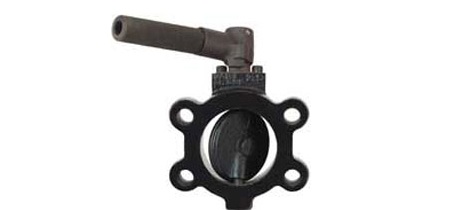The W. E. Anderson Series SAEbutterfly valve is a unique product designed to SAE J518connection specifications. The J518 connection is considered to be a superior connection for hydraulics because the connection seal eliminates hydraulic fluid connection leaks associated with tapered thread and gasket type seals.
What is the SAE butterfly valve?
The SAE valve is a hand lever operated butterfly valve with a cast iron body and disc. Connections on the valve are an o-ring flange face seal type that conforms to SAE J518 specifications. A lined disc is featured in the SAE valve, and the valve is rated to 25 psi bubble tight shutoff. Available connection sizes are 2, 2-½, 3, 4, and 5 inch. An optional lever-locking handle is offered to assure that the valve is not closed inadvertently. Buna-N is the standard liner and o-ring with Viton available as an option.
What is SAE J518?
The fluid power industry has had a long history of difficulties with leaking connections and has tried to attain newer style fittings that eliminate this leaking problem. Also, the large variety of available fittings today makes the possibility of misapplication of fittings in the fluid power industry more prolific. SAE J518 is a standard for hydraulic flanged connections issued by the Society of Automotive Engineers. This connection design is a four-bolt flange to specific bolt dimensions with an o-ring flange face seal. Of all of the types of connections available for hydraulics the J518 is considered superior for its non-leaking traits provided by the o-ring flange face seal. Other styles of hydraulic connections involve metal to metal sealing at the tube, pipe, or hose connection of the fittings, which is prone to leakage. SAE J518 connections are also recognized internationally, included in ISO 6162, and are recommended for all hydraulic designs.
Markets and Applications
By creating the SAE valve around the requested desires of fluid control system manufacturers the valve’s features are expressly designed for the fluid power industry. Specifically, the valve was developed to provide a shutoff of the process media to the suction side of a pump. The most common use of the valve is to provide isolation of the reservoir side of a hydraulic system to prevent loss of hydraulic fluid while servicing the pump.
Hydraulic systems, industrial oil systems, transmission oil systems, and engine oil systems are perfect markets that have applications for the valve. Popular applications are injection molding machinery, heavy earth moving equipment, hydraulic lift systems, and hydraulic power stations.
Features of the SAE Valve
There are many features of the SAE butterfly valve including a stem and vane assembly that utilizes an up and downward thrust bearing for permanent sealing alignment. The valve allows for adjustment by incorporating an open/close detent position lock, which can be infinitely positioned to achieve a desired flow rate. From the valve’s unique design it resists the vibrations associated with hydraulic pumps and pumping systems. An additional selling feature of the valve is a small profile with compact handle that reduces space requirements.
Cost saving features of the valve are flange bolt guide holes that eliminate the need for centering, improper torque sequence, and mating during installation thereby reducing labor costs. Connections on the valve are designed to allow for direct mounting to a reservoir or pump inlet eliminating the need for adapters that are necessary for other types of connections further reducing the cost of installation and the need to inventory those adapters. The construction of the valve enables easy disassembly and reassembly for maintenance compared to valves with other types of connections.




